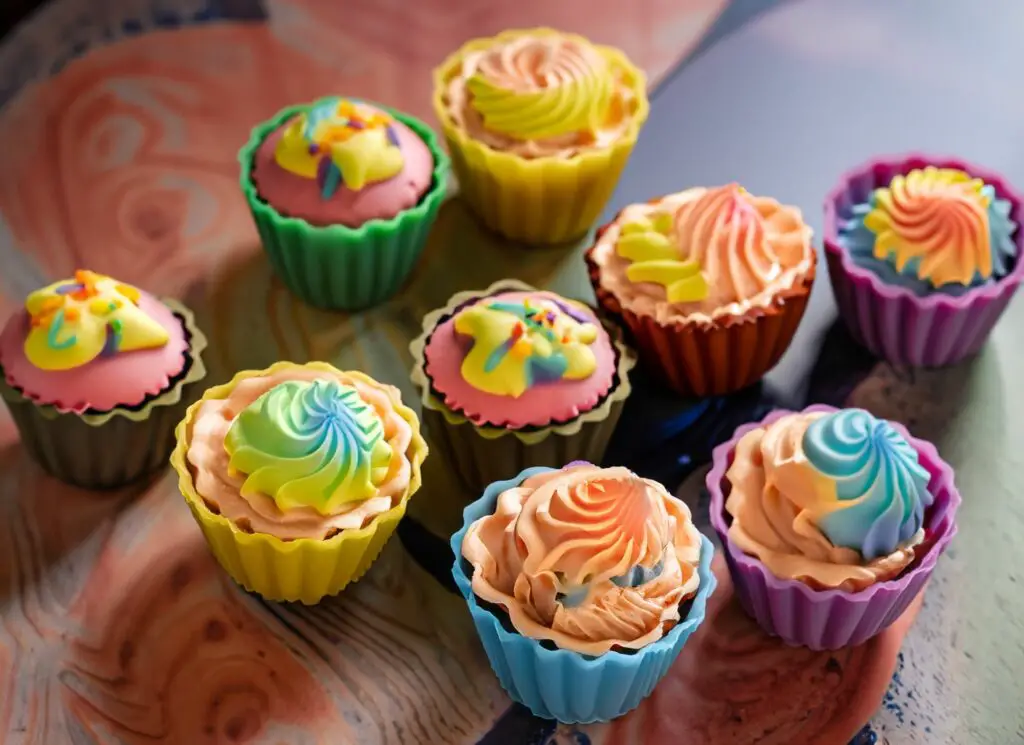Are you tired of your baked goods sticking to traditional pans?
Discover the benefits of baking with silicone molds and learn valuable tips, delicious recipes, and important safety guidelines for successful baking.
As an avid baker who has experimented with various bakeware materials, I can help you navigate the world of silicone molds and create stunning treats.
Baking with Silicone Molds: An Overview

Baking with silicone molds has become increasingly popular in recent years. The advantages of using these molds are numerous, including their flexibility, non-stick properties, and the ability to create a wide variety of treats. In this article, we will explore baking with silicone molds and how to make the most of this versatile bakeware.
Key Takeaway: Silicone molds offer flexibility, non-stick properties, and endless creative possibilities for bakers.
Temperature Recommendations for Baking with Silicone Molds
Silicone molds can typically withstand a temperature range of -40°F to 500°F. However, it is crucial to check the specific temperature tolerance of individual molds before using them. Using the appropriate temperature is essential for successful baking and avoiding damage to the molds. Keep in mind the baking with silicone molds temperature when planning your next baking project.
Tip: Always check the specific temperature tolerance of your silicone mold before baking.
Greasing Techniques for Silicone Molds
One of the main benefits of silicone molds is their non-stick surface. In most cases, you won’t need to grease them before baking. However, there are certain situations where greasing might be necessary, such as intricate designs or recipes prone to sticking. So, do silicone molds need to be greased before baking? Generally, no – but it’s always good to be prepared for those special cases.
Key Takeaway: Most silicone molds do not require greasing due to their non-stick surface.
Cleaning and Maintenance of Silicone Molds
Cleaning silicone molds is a breeze. You can either handwash them with warm soapy water or place them in a dishwasher. To avoid damaging the molds, steer clear of abrasive scrubbers and sharp objects. Proper maintenance is crucial for prolonging the lifespan of your silicone molds.
Tip: Avoid using abrasive scrubbers and sharp objects when cleaning silicone molds.
Safety Considerations for Baking with Silicone Molds
Silicone molds are considered safe for baking purposes. It’s essential to use food-grade silicone, which is non-toxic and free from harmful chemicals like BPA and phthalates. Always purchase molds from reputable manufacturers to ensure their safety. Are silicone molds microwave safe? Yes, they are! And when it comes to oven use, you can place silicone bakeware directly on the oven rack without any issues.
Key Takeaway: Choose food-grade silicone molds from reputable manufacturers for safe baking.
Creative Recipe Ideas for Silicone Molds
The possibilities are endless when it comes to baking silicone molds recipes. You can create simple cakes, elaborate desserts, cupcakes, cookies, and other treats using these versatile molds. Don’t be afraid to experiment with different flavors, fillings, and decorations to unleash your creativity.
Some Recipe Ideas:
- Mini cheesecakes
- Chocolate lava cakes
- Madeleines
- Cake pops
- Ice cream sandwiches
Tip: Experiment with different flavors, fillings, and decorations when using silicone molds.
Tips for Baking with Silicone Molds
To achieve the best results when baking with silicone molds, consider the following tips:
- Adjust baking times and temperatures: Silicone molds may require slightly lower temperatures and longer baking times compared to traditional bakeware.
- Handle delicate designs with care: Use a cookie sheet or baking tray underneath the mold for added stability.
- Troubleshoot common issues: If your baked goods are sticking to the mold, try freezing them for a few minutes before removing them.
- Use smaller molds. Silicone molds are typically smaller than traditional metal or ceramic baking pans, so you’ll need to adjust your recipes accordingly. For example, if you’re baking a cake in a traditional 9×13 inch pan, you’ll need to use a 6-cup silicone mold.
- Preheat your oven. It’s important to preheat your oven before baking with silicone molds. This will help ensure that your baked goods cook evenly.
- Grease your molds. Silicone molds don’t need to be greased as often as traditional metal or ceramic baking pans, but it’s still a good idea to do so. This will help prevent your baked goods from sticking to the mold.
- Fill the molds to the correct level. Silicone molds are flexible, so it’s important to fill them to the correct level. If you fill them too high, your baked goods may overflow.
- Bake for the correct amount of time. Silicone molds can cook at different rates than traditional metal or ceramic baking pans. Be sure to check your baked goods for doneness at the minimum baking time indicated in the recipe.
- Let your baked goods cool completely before removing them from the molds. This will help prevent them from breaking.
- Clean your molds immediately after use. This will help prevent food from sticking to the mold and make it easier to clean.
Key Takeaway: Adjust baking times and temperatures, handle delicate designs with care, and troubleshoot common issues for successful baking with silicone molds.
FAQs About Bake with Silicone Mold
Can you bake in silicone molds?
Yes, silicone molds are designed for baking purposes.
What temperature can you bake with silicone molds?
Generally, between -40°F and 500°F – but always check the specific temperature tolerance of your mold.
How do you bake in silicone molds?
Simply fill the molds with your desired batter or dough and bake according to the recipe’s instructions.
How to use silicone molds for baking?
Grease the molds if necessary, fill them with your chosen recipe, and bake at the appropriate temperature.
How to remove cake from silicone mold?
Allow the cake to cool, then gently flex the mold to release the cake.
How to prevent sticking in silicone molds?
Most silicone molds are non-stick, but if you encounter sticking issues, try greasing the mold or freezing the baked goods before removing them.
Summary
In summary, baking with silicone molds offers numerous benefits, including flexibility, non-stick properties, and endless creative possibilities. By following safety guidelines and maintenance tips, you can ensure a successful and enjoyable baking experience. So go ahead and explore the world of silicone molds – your taste buds will thank you!
Key Takeaway: Baking with silicone molds provides a versatile and enjoyable experience when following safety guidelines and maintenance tips.


